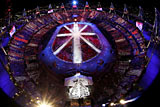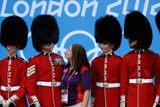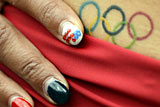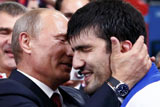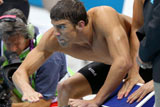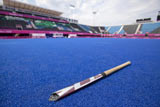Volleyball
Updated: 2012-05-15 10:13:24
(london2012.com)
|
|||||||||||
In 1895, William G Morgan devised a game he called 'mintonette', which he intended as a gentle alternative to basketball for older members of his YMCA gym. A century later, Volleyball is anything but gentle - few sports on the Olympic program offer such fast and exhileration action.
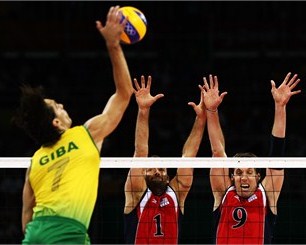 |
Competition dates
July 28 - Aug 12
Competition venue
Earls Court
Number of medal events
One men's and one women's competition.
Number of competitors
144 men and 144 women. Twelve teams compete in both the men's and women's competitions, with 12 athletes on each team (six players and six substitutes).
Each country is limited to one men's and one women's team.
Field of play
The volleyball court is 18m long and 9m wide. It is divided into two halves by a net that is 2.43m high for the men's game, and 2.24m high for the women's.
History of Volleyball at the Olympics
Volleyball made its Olympic debut at the Tokyo 1964 Games for both men and women. At Beijing 2008, the gold medals were won by the USA (men) and Brazil (women).
The basics
Volleyball is played by two teams of six. The object of the game is to land the ball in the opposition's half of the court.
Each team is allowed three touches of the ball before it must cross over the net. The key attacking move is the set and spike, in which a player feeds the ball (the set) for a teammate to power it into the opposition's court (the spike). Volleyball requires power and quick reactions: in the men's game, the ball can reach speeds in excess of 130km/h.
The match starts with three front-row players in a line near the net, and three back-row players in a line towards the back of the court. At each serving opportunity, the players rotate one space.
Each team has the opportunity to have one libero among their players on court. The libero is a specialist defensive player, and may not play any attacking shots. The libero is easy to identify as his/her kit will be a different colour to the rest of the team.
Competition format
At London 2012, both the men's and women's Volleyball competitions begin with a preliminary phase: the 12 teams in each event are divided into two pools of six, and each team plays every other team in their pool. The eight best teams (the top four from each pool) from this phase qualifies for the knockout phase, with the winners of the semi-finals eventually going head to head for the gold.
All matches are the best of five sets, with the first four sets going to 25 points. The fifth set goes to 15 points, and all sets must be won with at least a two-point advantage.
Officials
Two referees oversee each game. One sits on an elevated chair at the side of the court and the second is positioned on the other side of the court. They are assisted by scorers, who sit at the scorers' table, and line judges, who stand at the corners of the court and indicate various line faults with the use of flags.
Keys to success
Volleyball is a fast and physically demanding game. Height is a distinct advantage, but players also need to have speed, strength and stamina as well as excellent technical play and the ability to think on their feet and play tactically as a team.
Breaking the rules
Volleyball is a very technical game, and a team that commits too many infringements (such as touching the top net band when playing the ball, or catching/throwing the ball) will lose possession, and potentially players. If a player receives a yellow card, a penalty is awarded to the opposition; if a player receives a red card, he/she is expelled for the remainder of the set; and if a player receives a red and yellow card together, he/she is expelled for the rest of the match. In a team of only six players on court, to lose one, even for a short time, gives the opposing team a real advantage.
Jargon buster
Spike - to smash the ball overarm into the opponent's court.
Block - preventing the attacking ball from coming over the net by forming a wall of hands at the net.
Dig - a defensive passing shot from close to the ground, usually following an opposition spike.
Setter - the player who sets the ball for the attacker, usually on the second of the team's three permitted shots.
Wipe - to return the ball off an opposing block so it lands out of bounds.
Medal Count |
||||
| 1 | 46 | 29 | 29 | |
| 2 | 38 | 27 | 22 | |
| 3 | 29 | 17 | 19 | |
| 4 | 24 | 25 | 33 | |
| 5 | 13 | 8 | 7 | |
| 6 | 11 | 19 | 14 | |

